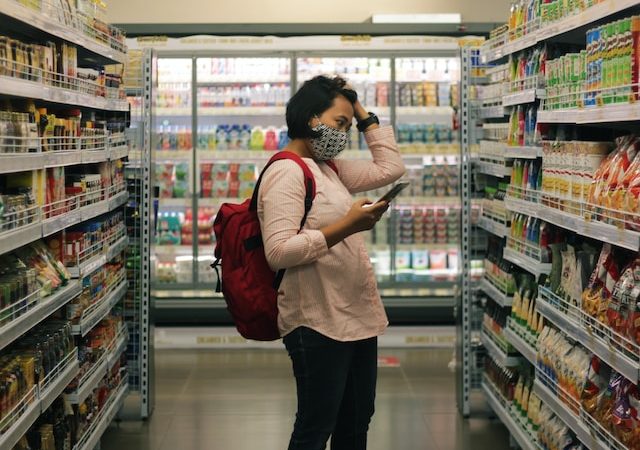The outbreak of COVID-19 has brought a wave of change across multiple industries, and the grocery industry is no exception. With lockdowns and social distancing measures in place, people are turning to online grocery delivery services more than ever before. What was once seen as a mere convenience has become an essential service for many
The outbreak of COVID-19 has brought a wave of change across multiple industries, and the grocery industry is no exception. With lockdowns and social distancing measures in place, people are turning to online grocery delivery services more than ever before. What was once seen as a mere convenience has become an essential service for many households around the world. In this blog post, we’ll take a closer look at how COVID-19 has impacted the growth of online grocery delivery and what this means for the future of the industry.
Background
The grocery industry has been a vital part of our daily lives for decades, but COVID-19 has brought about an unprecedented shift in the way we shop for groceries. With social distancing measures and stay-at-home orders in place, many people have turned to online grocery delivery as a safer alternative to traditional shopping.
Online grocery delivery services are not new – companies like Instacart and Amazon Fresh have been around for years. However, prior to the pandemic, these services were seen more as a convenience rather than a necessity. But with the outbreak of COVID-19, online grocery delivery has become an essential service that is relied upon by millions of people worldwide.
The surge in demand for online grocery delivery has caused significant changes within the industry. Many retailers who previously had little or no presence in e-commerce have rushed to build out their digital capabilities to meet consumer needs. Additionally, companies that already had established e-commerce channels have had to scale-up operations rapidly to keep up with demand.
Despite some initial challenges such as supply chain disruptions and increased order volume causing delays, most online grocers have adapted quickly and continue to provide reliable service during this time of crisis. As we move forward into an uncertain future post-COVID-19 era, it remains clear that online grocery delivery will be here to stay as consumers increasingly rely on this convenient and safe way of purchasing their essentials.
What is COVID-19?
COVID-19, also known as the coronavirus disease 2019, is a highly infectious respiratory illness caused by the SARS-CoV-2 virus. It was first identified in December 2019 in Wuhan, China and has since spread globally to become an ongoing pandemic.
The symptoms of COVID-19 can range from mild to severe and may include fever, coughing, sore throat, muscle pain or fatigue. In some cases it can cause difficulty breathing or pneumonia which can lead to hospitalization and even death.
COVID-19 spreads through droplets produced when an infected person talks, coughs or sneezes. These droplets can land on surfaces where they remain for hours or even days making it easy for others to contract the virus.
In response to this global outbreak several measures have been put in place including social distancing rules and lockdowns aimed at slowing down its spread. The impact of COVID-19 on various industries including grocery delivery services has been significant due to changes in consumer behavior brought about by fear of infection.
How Does COVID-19 Affect Grocery Delivery?
COVID-19 has had a significant impact on the growth of online grocery delivery. With social distancing measures and lockdowns imposed in many countries, consumers have turned to online shopping for their groceries more than ever before.
One of the most obvious effects of COVID-19 on grocery delivery is an increase in demand. As people are staying home to avoid exposure to the virus, they need a convenient way to get food and other essentials delivered directly to their doorstep.
This surge in demand has also led to changes in how grocery delivery services operate. Many companies have increased their capacity by hiring more staff or partnering with other retailers. They’ve also implemented new safety protocols such as contactless deliveries and mandatory mask-wearing for employees.
Furthermore, COVID-19 has accelerated the adoption of technology in the world of grocery delivery. Retailers are investing heavily in e-commerce platforms, mobile apps, and artificial intelligence-powered logistics systems that can optimize routes and inventory management.
While COVID-19 has caused widespread disruption across many industries, it’s clear that online grocery delivery will continue to grow as a result of this pandemic-induced shift towards convenience and necessity.
Conclusion
The impact of COVID-19 on the growth of online grocery delivery has been significant. The pandemic has forced many people to stay at home and avoid going out as much as possible. This has led to an increase in demand for online grocery delivery services, which have become not just a convenience but a necessity.
As people continue to prioritize their health and safety during the pandemic, it is likely that this trend will continue even after things return to “normal.” Online grocery delivery services offer a convenient way for people to stock up on essential items without leaving their homes.
The COVID-19 pandemic has accelerated the growth of online grocery delivery and transformed it from a luxury into an essential service. As we look towards the future, it is clear that businesses in this industry must adapt quickly to meet changing consumer needs if they want to succeed in this new normal.

















Leave a Comment
Your email address will not be published. Required fields are marked with *